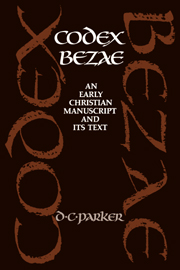Book contents
- Front Matter
- Contents
- List of illustrations
- Preface
- Abbreviations and textual conventions
- Introduction
- PART I The palaeography
- PART II The scribe and the tradition
- Chapter Five The sense-lines
- Chapter Six The nomina sacra
- Chapter Seven The orthography
- Chapter Eight The Codex Bezae and its ancestors
- PART III The correctors
- PART IV The bilingual tradition
- Part V Text and codex
- Appendices
- Plates
- Notes on the plates
- Indexes
Chapter Eight - The Codex Bezae and its ancestors
Published online by Cambridge University Press: 09 November 2009
- Front Matter
- Contents
- List of illustrations
- Preface
- Abbreviations and textual conventions
- Introduction
- PART I The palaeography
- PART II The scribe and the tradition
- Chapter Five The sense-lines
- Chapter Six The nomina sacra
- Chapter Seven The orthography
- Chapter Eight The Codex Bezae and its ancestors
- PART III The correctors
- PART IV The bilingual tradition
- Part V Text and codex
- Appendices
- Plates
- Notes on the plates
- Indexes
Summary
In Part II we have studied the sense-lines, the nomina sacra, and the orthography (chapters 5–7), in an attempt to learn more about the manuscript tradition that lies behind D. The third of these chapters yielded very little fresh evidence, but what we have found enables us to interpret more coherently the evidence from the other two chapters. We therefore begin the conclusion to this part by taking up the implications of what we learnt about the orthography.
We direct our attention first toward the Gospels.
John has two peculiar features in its Greek side. First, the use of the apostrophe after Aβρααμ; second, the change in chapter 5 from the double form to the single in the writing Iωανης, which, it should be noted, is only partly shared by the Latin column. This change makes it possible that an earlier manuscript could have had the Gospels in the order Matthew–Mark–John–Luke. Although the agreement between the columns could be chance, it is more likely to indicate that this earlier manuscript was a bilingual. It could be that a copy of John had been written at some stage, either by two scribes, or from two exemplars, the change coming in the middle of chapter 5. This could have occurred at any stage in the history of the transmission. (Since all the occurrences of Abraham in the Fourth Gospel come in chapter 8 onwards, the use of the apostrophe does not help us.)
- Type
- Chapter
- Information
- Codex BezaeAn Early Christian Manuscript and its Text, pp. 112 - 120Publisher: Cambridge University PressPrint publication year: 1992



